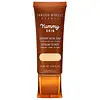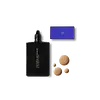Danessa Myricks Beauty Yummy Skin Serum Skin Tint Versus Victoria Beckham Beauty The Foundation Drops With TFC8
What's inside
What's inside
 Key Ingredients
Key Ingredients

 Benefits
Benefits

 Concerns
Concerns

 Ingredients Side-by-side
Ingredients Side-by-side

Water
Skin ConditioningGlycerin
HumectantIsododecane
EmollientDimethicone
EmollientPropylene Glycol
HumectantCalcium Sodium Borosilicate
Caprylic/Capric Triglyceride
MaskingHydrogenated Polyisobutene
EmollientSqualane
EmollientXylitylglucoside
HumectantAnhydroxylitol
HumectantSr-Hydrozoan Polypeptide-1
HumectantSodium Hyaluronate
HumectantCeramide NP
Skin ConditioningPhytosterols
Skin ConditioningOpunta Dillenii Extract
Xylitol
HumectantCaprylhydroxamic Acid
Saccharide Isomerate
HumectantSodium Stearoyl Glutamate
CleansingTocopheryl Acetate
AntioxidantStearalkonium Hectorite
Gel FormingPropylene Carbonate
SolventCoco-Caprylate/Caprate
EmollientGlyceryl Stearate
EmollientBetaine
HumectantMagnesium Sulfate
Glyceryl Caprylate
EmollientPentylene Glycol
Skin ConditioningPolyglyceryl-4 Diisostearate/Polyhydroxystearate/Sebacate
EmulsifyingSorbitan Isostearate
EmulsifyingButylene Glycol
HumectantPhosphatidylcholine
EmulsifyingHydroxyacetophenone
AntioxidantEthylhexyl Hydroxystearate
EmollientCetyl PEG/PPG-10/1 Dimethicone
EmulsifyingTriethoxycaprylylsilane
Aluminum Hydroxide
EmollientPotassium Sorbate
PreservativePhenoxyethanol
PreservativeCI 77163
Cosmetic ColorantTitanium Dioxide
Cosmetic ColorantIron Oxides
Water, Glycerin, Isododecane, Dimethicone, Propylene Glycol, Calcium Sodium Borosilicate, Caprylic/Capric Triglyceride, Hydrogenated Polyisobutene, Squalane, Xylitylglucoside, Anhydroxylitol, Sr-Hydrozoan Polypeptide-1, Sodium Hyaluronate, Ceramide NP, Phytosterols, Opunta Dillenii Extract, Xylitol, Caprylhydroxamic Acid, Saccharide Isomerate, Sodium Stearoyl Glutamate, Tocopheryl Acetate, Stearalkonium Hectorite, Propylene Carbonate, Coco-Caprylate/Caprate, Glyceryl Stearate, Betaine, Magnesium Sulfate, Glyceryl Caprylate, Pentylene Glycol, Polyglyceryl-4 Diisostearate/Polyhydroxystearate/Sebacate, Sorbitan Isostearate, Butylene Glycol, Phosphatidylcholine, Hydroxyacetophenone, Ethylhexyl Hydroxystearate, Cetyl PEG/PPG-10/1 Dimethicone, Triethoxycaprylylsilane, Aluminum Hydroxide, Potassium Sorbate, Phenoxyethanol, CI 77163, Titanium Dioxide, Iron Oxides
Water
Skin ConditioningIsoamyl Laurate
EmollientCoco-Caprylate/Caprate
EmollientHydrogenated Ethylhexyl Olivate
EmollientPropanediol
SolventEthylhexyl Polyhydroxystearate
EmollientPolyglyceryl-3 Polyricinoleate
EmulsifyingPolyglyceryl-4 Isostearate
EmulsifyingShea Butter Ethyl Esters
EmollientPolyglyceryl-2 Triisostearate
EmulsifyingCaprylic/Capric Triglyceride
MaskingSorbitan Isostearate
EmulsifyingSynthetic Fluorphlogopite
Mica
Cosmetic ColorantDisteardimonium Hectorite
StabilisingGlycerin
HumectantEchinacea Purpurea Extract
MoisturisingAcmella Oleracea Extract
Skin ProtectingOlea Europaea Leaf Extract
PerfumingDimethyl Isosorbide
SolventSqualane
EmollientPolyglyceryl-2 Tetraisostearate
EmollientSimmondsia Chinensis Seed Oil
EmollientSodium Phytate
Lauroyl Lysine
Skin ConditioningHydrolyzed Rice Protein
Skin ConditioningOpuntia Ficus-Indica Stem Extract
Skin ConditioningPentylene Glycol
Skin ConditioningArginine
MaskingGlycine
BufferingLysine
Skin ConditioningOligopeptide-177
Oligopeptide-4
Skin ConditioningPhenylalanine
MaskingSisymbrium Irio Seed Oil
MaskingHydrogenated Olive Oil Unsaponifiables
EmollientTocopheryl Acetate
AntioxidantGlyceryl Ricinoleate
EmollientLecithin
EmollientButylene Glycol
HumectantXanthan Gum
Emulsifying1,2-Hexanediol
Skin ConditioningCaprylyl Glycol
EmollientPhenylpropanol
MaskingSodium Dehydroacetate
PreservativeSodium Chloride
MaskingTocopherol
AntioxidantPotassium Sorbate
PreservativeSodium Hydroxide
BufferingAluminum Hydroxide
EmollientCI 77891
Cosmetic ColorantIron Oxides
Water, Isoamyl Laurate, Coco-Caprylate/Caprate, Hydrogenated Ethylhexyl Olivate, Propanediol, Ethylhexyl Polyhydroxystearate, Polyglyceryl-3 Polyricinoleate, Polyglyceryl-4 Isostearate, Shea Butter Ethyl Esters, Polyglyceryl-2 Triisostearate, Caprylic/Capric Triglyceride, Sorbitan Isostearate, Synthetic Fluorphlogopite, Mica, Disteardimonium Hectorite, Glycerin, Echinacea Purpurea Extract, Acmella Oleracea Extract, Olea Europaea Leaf Extract, Dimethyl Isosorbide, Squalane, Polyglyceryl-2 Tetraisostearate, Simmondsia Chinensis Seed Oil, Sodium Phytate, Lauroyl Lysine, Hydrolyzed Rice Protein, Opuntia Ficus-Indica Stem Extract, Pentylene Glycol, Arginine, Glycine, Lysine, Oligopeptide-177, Oligopeptide-4, Phenylalanine, Sisymbrium Irio Seed Oil, Hydrogenated Olive Oil Unsaponifiables, Tocopheryl Acetate, Glyceryl Ricinoleate, Lecithin, Butylene Glycol, Xanthan Gum, 1,2-Hexanediol, Caprylyl Glycol, Phenylpropanol, Sodium Dehydroacetate, Sodium Chloride, Tocopherol, Potassium Sorbate, Sodium Hydroxide, Aluminum Hydroxide, CI 77891, Iron Oxides
 Reviews
Reviews

Ingredients Explained
These ingredients are found in both products.
Ingredients higher up in an ingredient list are typically present in a larger amount.
Aluminum Hydroxide is a form of aluminum. It can be naturally found in nature as the mineral gibbsite. In cosmetics, Aluminum Hydroxide is used as a colorant, pH adjuster, and absorbent.
As a colorant, Aluminum Hydroxide may add opacity, or reduce the transparency. Aluminum hydroxide is contains both basic and acidic properties.
According to manufacturers, this ingredient is an emollient and humectant. This means it helps hydrate the skin.
In medicine, this ingredient is used to help relieve heartburn and help heal ulcers.
There is currently no credible scientific evidence linking aluminum hydroxide in cosmetics to increased cancer risk.
Major health organizations allow the use of aluminum hydroxide in personal care products and have not flagged it as a carcinogenic risk at typical usage levels.
Learn more about Aluminum HydroxideButylene Glycol (or BG) is used within cosmetic products for a few different reasons:
Overall, Butylene Glycol is a safe and well-rounded ingredient that works well with other ingredients.
Though this ingredient works well with most skin types, some people with sensitive skin may experience a reaction such as allergic rashes, closed comedones, or itchiness.
Learn more about Butylene GlycolThis ingredient is an emollient, solvent, and texture enhancer. It is considered a skin-softener by helping the skin prevent moisture loss.
It helps thicken a product's formula and makes it easier to spread by dissolving clumping compounds.
Caprylic Triglyceride is made by combining glycerin with coconut oil, forming a clear liquid.
While there is an assumption Caprylic Triglyceride can clog pores due to it being derived from coconut oil, there is no research supporting this.
Learn more about Caprylic/Capric TriglycerideCoco-Caprylate/Caprate is created from fatty coconut alcohol, caprylic acid, and capric acid.
It is a lightweight emollient. Emollients create a thin barrier on the skin to trap moisture in. This helps keep your skin hydrated and soft.
Once applied, Coco-Caprylate/Caprate is absorbed quickly and leaves a silky feel.
Coco-Caprylate/Caprate may not be fungal acne safe.
Learn more about Coco-Caprylate/CaprateGlycerin is already naturally found in your skin. It helps moisturize and protect your skin.
A study from 2016 found glycerin to be more effective as a humectant than AHAs and hyaluronic acid.
As a humectant, it helps the skin stay hydrated by pulling moisture to your skin. The low molecular weight of glycerin allows it to pull moisture into the deeper layers of your skin.
Hydrated skin improves your skin barrier; Your skin barrier helps protect against irritants and bacteria.
Glycerin has also been found to have antimicrobial and antiviral properties. Due to these properties, glycerin is often used in wound and burn treatments.
In cosmetics, glycerin is usually derived from plants such as soybean or palm. However, it can also be sourced from animals, such as tallow or animal fat.
This ingredient is organic, colorless, odorless, and non-toxic.
Glycerin is the name for this ingredient in American English. British English uses Glycerol/Glycerine.
Learn more about GlycerinPentylene glycol is typically used within a product to thicken it. It also adds a smooth, soft, and moisturizing feel to the product. It is naturally found in plants such as sugar beets.
The hydrophilic trait of Pentylene Glycol makes it a humectant. As a humectant, Pentylene Glycol helps draw moisture from the air to your skin. This can help keep your skin hydrated.
This property also makes Pentylene Glycol a great texture enhancer. It can also help thicken or stabilize a product.
Pentylene Glycol also acts as a mild preservative and helps to keep a product microbe-free.
Some people may experience mild eye and skin irritation from Pentylene Glycol. We always recommend speaking with a professional about using this ingredient in your routine.
Pentylene Glycol has a low molecular weight and is part of the 1,2-glycol family.
Learn more about Pentylene GlycolPotassium Sorbate is a preservative used to prevent yeast and mold in products. It is commonly found in both cosmetic and food products.
This ingredient comes from potassium salt derived from sorbic acid. Sorbic acid is a natural antibiotic and effective against fungus.
Both potassium sorbate and sorbic acid can be found in baked goods, cheeses, dried meats, dried fruit, ice cream, pickles, wine, yogurt, and more.
You'll often find this ingredient used with other preservatives.
Learn more about Potassium SorbateSorbitan Isostearate is an emulsifer and cleaning agent. It is created from isostearic acid and sorbitol.
As an emulsifier, Sorbitan Isostearate prevents oils and water from separating.
Due to its isostearic acid base, it may not be safe for Malassezia or fungal acne.
Learn more about Sorbitan IsostearateSqualane is an emollient that helps the skin hold onto moisture. It's an oily liquid that occurs naturally in certain types of fish and plant oils.
Because squalane boosts hydration in the skin, it also comes with plenty of benefits: it is an antioxidant and can help fight free radicals and skin damage. Squalane is also found to have a detoxifying effect when applied.
Squalane comes from squalene, which occurs naturally within the sebum of our skin. It is one of the oils our skin produces to keep itself hydrated. Squalane is the hydrogenated version of squalene and has a longer shelf life.
Research shows that squalane is non-irritating (even at 100% concentration).
In general, it's a fantastic ingredient. It does a great job at hydrating the skin, and it's suitable for those with sensitive skin.
The source of squalane may impact malassezia / fungal acne. This is because olive oil derived squalane can contain impurities such as fatty acids and plant waxes. Sugarcane derived squalane is recommended for anyone with malassezia concerns.
Is squalane vegan?
This depends on the source. Squalane can be derived from both plants and animals. Most squalane used in skincare comes from plants.
Please note: the source of squalane is only known if disclosed by the brand. We recommend reaching out to the brand if you have any questions about their squalane.
Read more about squalene with an "e".
Is squalane an oil?
Squalane is often called an oil, but it’s technically not; it’s a hydrocarbon, meaning it’s only made of carbon and hydrogen, unlike true oils which are triglycerides made of fatty acids and glycerol.
The term “oil-free” isn’t regulated, so companies can define it however they want. Some exclude all oils, while others just avoid mineral oil or comedogenic oils.
While some people avoid oils thinking they cause breakouts, the right kind of oil (or oil-like ingredient like squalane) can actually help balance and hydrate your skin. It’s worth testing out simple oils or squalane to see what works best for your skin.
Learn more about SqualaneTocopheryl Acetate is AKA Vitamin E. It is an antioxidant and protects your skin from free radicals. Free radicals damage the skin by breaking down collagen.
One study found using Tocopheryl Acetate with Vitamin C decreased the number of sunburned cells.
Tocopheryl Acetate is commonly found in both skincare and dietary supplements.
Learn more about Tocopheryl AcetateWater. It's the most common cosmetic ingredient of all. You'll usually see it at the top of ingredient lists, meaning that it makes up the largest part of the product.
So why is it so popular? Water most often acts as a solvent - this means that it helps dissolve other ingredients into the formulation.
You'll also recognize water as that liquid we all need to stay alive. If you see this, drink a glass of water. Stay hydrated!
Learn more about WaterThis ingredient is a combination of red, black, and yellow iron oxide pigments. This combination of colors is usually found in foundation, because it results in a "skin" color.